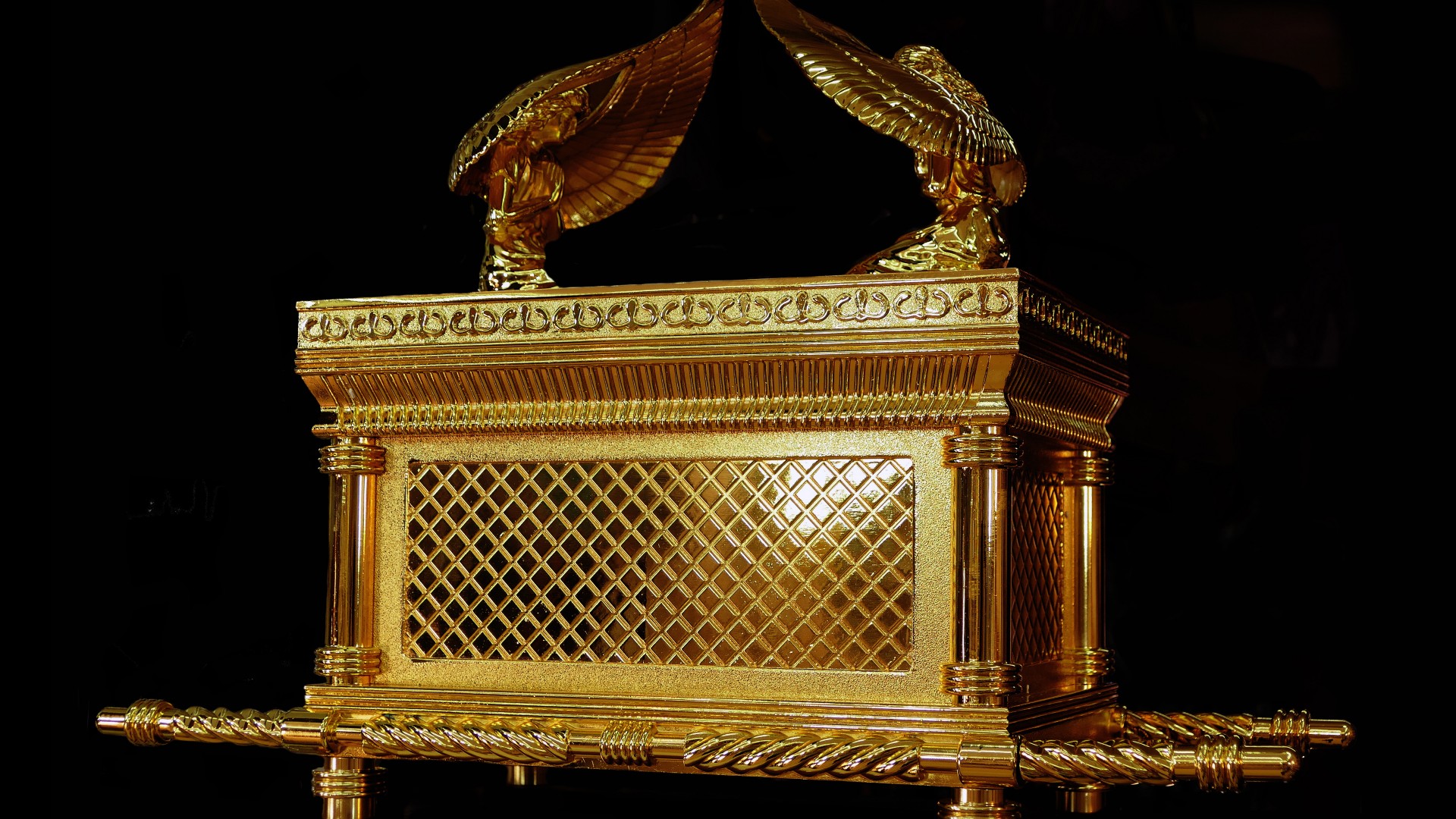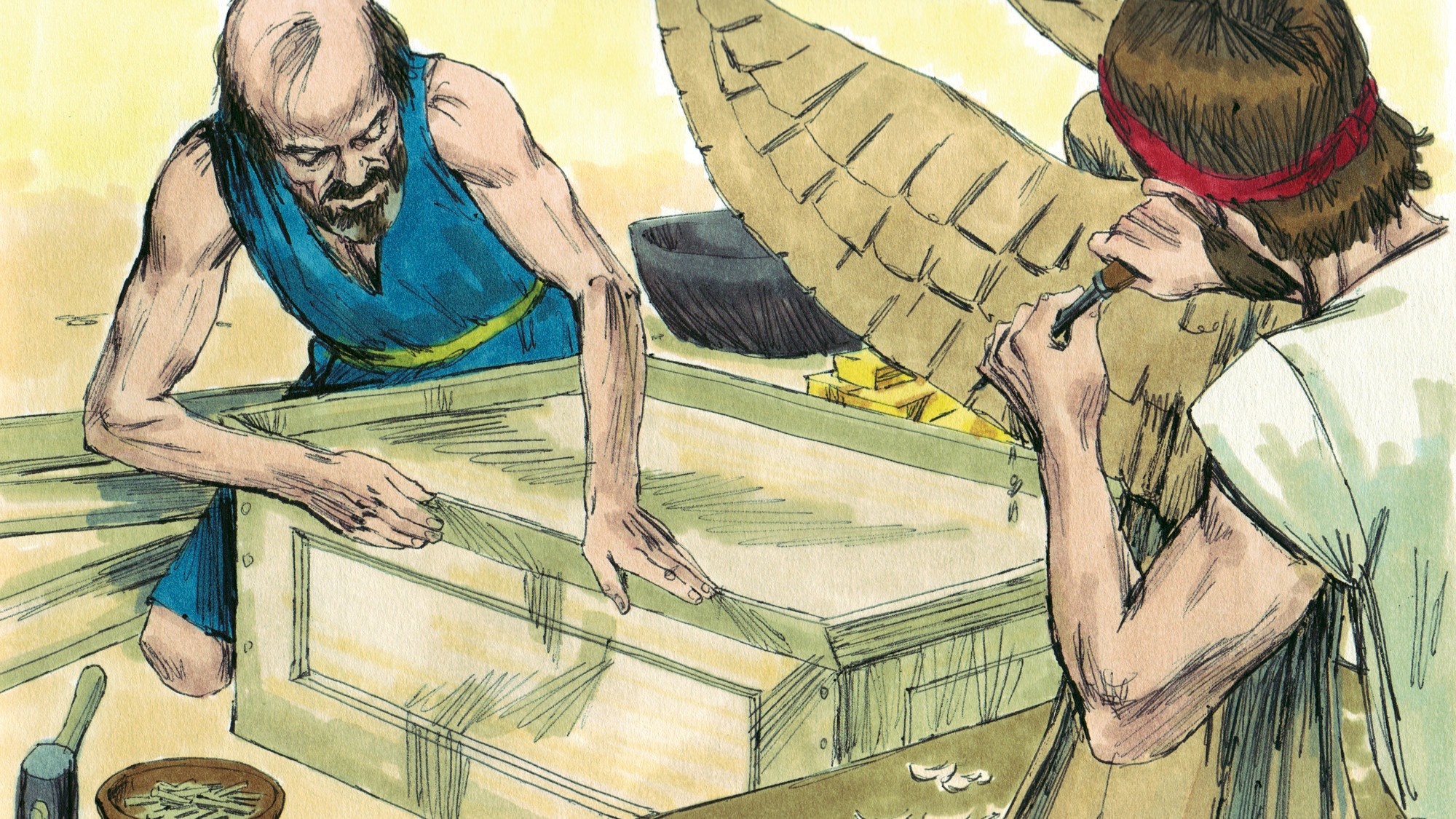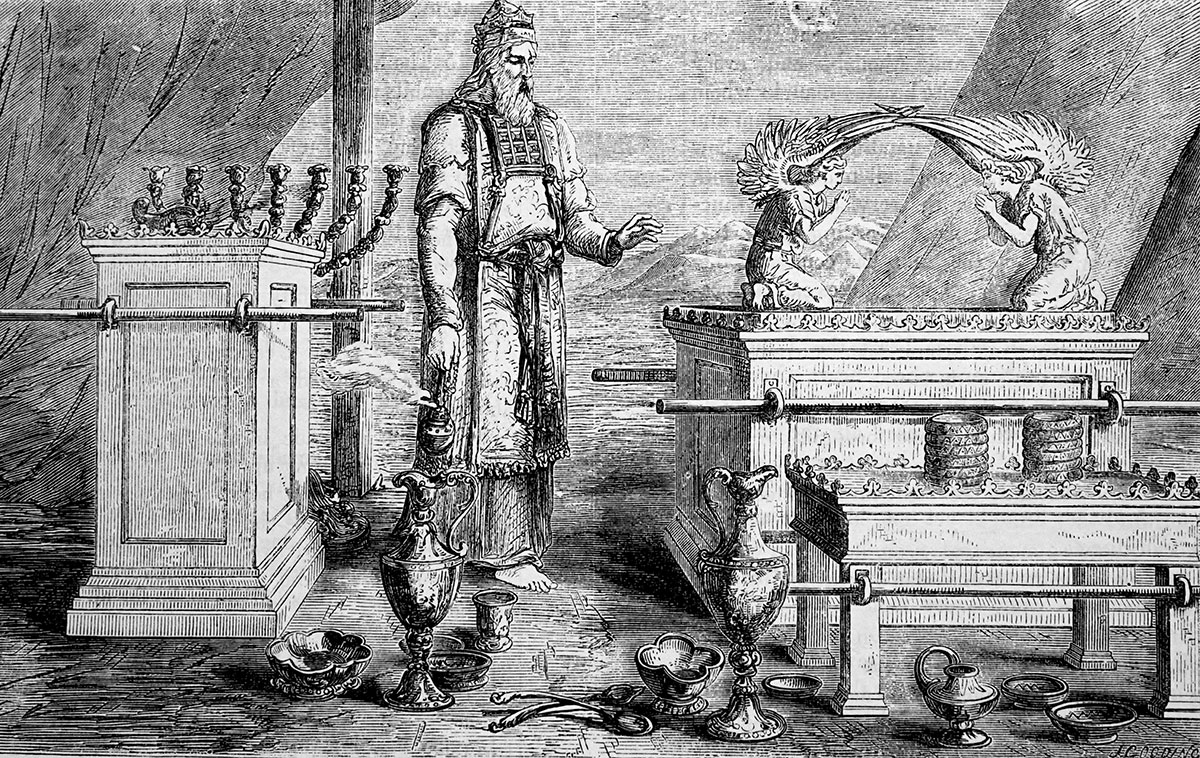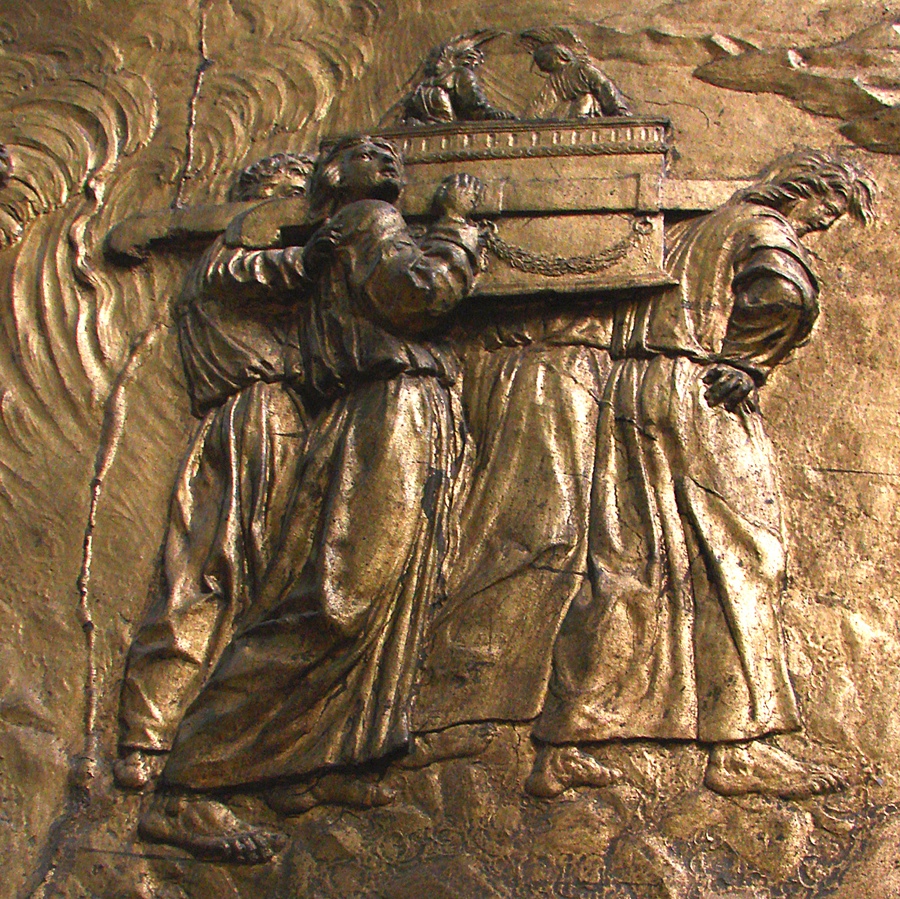What is the Ark of the Covenant?
The Ark of the Covenant is a chest for the original engraved tablets of the Ten Commandments, brought down Mount Sinai by Moses.

The Ark of the Covenant is a chest that is supposed to have held tablets engraved with the Ten Commandments, engraved by God for Moses on Mount Sinai, according to the Tanakh (Hebrew Bible) and Christian Old Testament.
According to the Hebrew Bible, the Ark was constructed by the Israelites while they were camping out in the Sinai Desert, after they fled Egypt. The Hebrew Bible doesn't specify when they fled Egypt, and there is a debate among scholars as to whether there ever was an exodus from Egypt. The Ark vanished when the Babylonians conquered Jerusalem in 587 B.C.
The ark has a number of seemingly magical powers, according to the Hebrew Bible. In one story, the Jordan River stopped flowing and remained still while a group of priests carrying the ark crossed the river. Other stories describe how the Israelites took the Ark with them into battle where the powers of the ark helped the Israelites defeat their enemies.
Related: Biblical battles: 12 ancient wars lifted from the Bible
"The military efficacy of the ark in the Ark narrative, however, is initially called into question, as the Ark is captured by the Philistines and taken by them to the temple of the god Dagon in Ashdod," wrote Susan Ackerman in "Eerdmans Dictionary of the Bible" (Eerdmans, 2000) edited by David Noel Freedman.
When the ark was captured by the Philistines, outbreaks of tumors and disease afflicted them, forcing the Philistines to return the ark to the Israelites. Some stories describe how death would come to anyone who touched the ark or looked inside it.
Where is the Ark of the Covenant?
The Ark moved around frequently according to the Hebrew Bible, but eventually it was settled in Ancient Israel. "The ark ended up permanently in Jerusalem, in the innermost chamber of the temple. The story of how it got there is found in 2 Sam. 6 and also in Ps. 132, one of the very few explicit mentions of the ark outside of Pentateuch and the historical books," wrote Ackerman.
Later it is thought to have been placed in the holy of holies in the Temple of Solomon, founded around 957 B.C. "With Solomon, the ark's story ends rather abruptly. Jewish tradition and most scholars presume that it remained in the temple for almost 400 years, until the destruction of Jerusalem by the Babylonians in 586 B.C., yet it is not mentioned in the list of spoils the Babylonians took from the temple… Perhaps this indicates that the ark was taken from Jerusalem already in the late 10th century, as part of the military campaign undertaken by Pharaoh Shishak during the reign of Solomon's son Rehoboam," wrote Ackerman.
It's not known what happened to the ark after the First Temple was destroyed by the Babylonians. According to the Book of Maccabees, the ark was hidden in a cave on Mount Nebo by the prophet Jeremiah who said that this "place shall remain unknown until God gathers his people together again and shows his mercy." 2 Maccabees 2:7.
Another story tells of how the ark was brought to Ethiopia and is now at the Church of Our Lady Mary of Zion in Axum. Supposedly, only the Guardian of the Ark is allowed to view this ark, but a scholar named Edward Ullendorff saw the Ark during World War II and found that it was not the original Ark,
Another story places it in Jordan and is chronicled in the Quran. "The Muslim version of events was based loosely on the well-known story in the Apocryphal second book of Maccabees, a late Jewish text, which relates that the Biblical prophet Jeremiah carried the Ark out of the Jewish Temple just before the Babylonians seized Jerusalem and destroyed the Temple in 587 B.C. Jeremiah took it across the River Jordan into what is today the kingdom of Jordan, hid it in a cave on Mount Nebo, the mountain from which Moses had gazed upon the Promised Land before the Israelite conquest of Canaan, and then sealed up the entrance to the cave. Some of the Prophet’s followers tried to find the path that Jeremiah had taken in order to find the Ark. He rebuked them and said that the Ark the sign of his kinship would remain hidden until God gathered his people together at the end of time," wrote Tudor Parfitt, a professor of religion at Florida International University, in his book "The Lost Ark of the Covenant: Solving the 2,500 year-old Mystery of the Fabled Biblical Ark" (Harper Collins, 2008).
There are many other stories of the Ark's survival that Parfitt mentioned in his book. There are stories about how it is hidden near Jerusalem, in the city of Mecca and even in New Guinea.
One text called the "Treatise of the Vessels" says that the ark "shall not be revealed until the day of the coming of the Messiah son of David…." And the Book of Revelation claims that the ark will not be seen again until the end times.
"Then God's temple in heaven was opened, and within his temple was seen the Ark of his Covenant. And there came flashes of lightning, rumblings, peals of thunder, an earthquake and a severe hailstorm." Revelation 11:19.
What was the Ark made of?

There are two biblical stories describing the construction of the ark. The first, and most famous version, is found in the Book of Exodus and describes how a large amount of gold was used to build the Ark. The second version, found in the Book of Deuteronomy, briefly describes the construction of an Ark made just of wood.
Understanding the stories surrounding the Ark is challenging because of the different accounts. Some scholars believe that multiple arks may have been constructed and used at the same time or at different times.
The story of the construction of the ark told in the Book of Exodus describes in great detail how God ordered Moses to tell the Israelites to build an ark out of wood and gold, with God supposedly giving very precise instructions.
"Have them make an ark of acacia wood — two and a half cubits [3.75 feet or 1.1 meters] long, a cubit and a half [2.25 feet or 0.7 meters] wide, and a cubit and a half [2.25 feet] high. Overlay it with pure gold, both inside and out, and make a gold molding around it." Exodus 25:10-11.
Poles made of acacia wood and gold were used to carry the ark and two cherubim (angels) were to be sculpted out of gold and placed on the lid of the ark. "The cherubim are to have their wings spread upward, overshadowing the cover with them. The cherubim are to face each other, looking toward the cover." Exodus 25:20. Tablets engraved with the Ten Commandments were placed inside the ark.
The Hebrew Bible directed that the Ark of the Covenant be placed within a movable shrine known as the tabernacle. A curtain that prevented people from viewing the Ark of the Covenant was set up within the tabernacle and an altar and incense burners were placed in front of the curtain. The incense was made of gum resin, onycham, galbanum and frankincense, and was to be burned by Aaron, the brother of Moses, and his sons at morning and sunset.

A man named Bezalel was chosen by God to build the Ark of the Covenant and furnishings located within the tabernacle, according to the Hebrew Bible. "I have filled him with the Spirit of God, with wisdom, with understanding, with knowledge and with all kinds of skills — to make artistic designs for work in gold, silver and bronze, to cut and set stones, to work in wood, and to engage in all kinds of crafts." Exodus 31:3-5. Oholiab was chosen by God to be Bezalel's assistant, with skilled craftsmen helping them, the Hebrew Bible recounts.
During the reign of King Solomon, the First Temple, which is the holiest place in Judaism, was constructed in Jerusalem and the Ark of the Covenant was placed in an inner sanctuary covered in gold, the Hebrew Bible says.
The Book of Deuteronomy, on the other hand, tells the story of the construction of a much more modest Ark of the Covenant. The book says that at one point the Israelis were worshipping a golden calf instead of God. Moses was so enraged by this that he smashed the stone tablets engraved with the Ten Commandments. God ordered Moses to help create new tablets engraved with the Ten Commandments and create a wooden ark that they could be placed in.
"Chisel out two stone tablets like the first ones and come up to me on the mountain. Also make a wooden ark. I will write on the tablets the words that were on the first tablets, which you broke. Then you are to put them in the ark." Deuteronomy 10:1-2.
"So I [Moses] made the ark out of acacia wood and chiseled out two stone tablets like the first ones, and I went up on the mountain with the two tablets in my hands. The Lord wrote on these tablets what he had written before, the Ten Commandments he had proclaimed to you on the mountain…." Deuteronomy 10:3-4. Moses then put the tablets inside the wooden ark.
Were there multiple Arks?
It's possible that there were multiple arks that could have been used at the same or different times.
"Before all the cultic affairs of the Israelites were concentrated exclusively in the capital, Jerusalem, there had been arks, probably of different sorts, wherever [God] was worshipped," wrote Parfitt.
These early arks would have been "simple wooden containers," wrote Parfitt. After Israeli worship became centralized in Jerusalem the story may have been retold to describe one elaborate Ark of the Covenant made of gold, Parfitt wrote.

Additional resources and reading
Interested in knowing more about the real history behind Bible stories? Then you should read about these 7 biblical artifacts that will probably never be found.
On the other side of the coin, we recommend reading about what Satan really looks like, at least according to a variety of historical sources.
Bibliography
- "Eerdmans Dictionary of the Bible" edited by David Noel Freedman (Eerdmans, 2000)
- "The Lost Ark of the Covenant: Solving the 2,500 year-old Mystery of the Fabled Biblical Ark" by Tudor Parfitt (Harper Collins, 2008)
- "Fate of the Lost Ark Revealed?" History.com
- "Ancient Jewish History: The Ark of the Covenant" Jewish Virtual Library
- "Why the Ark of the Covenant is one of history's enduring mysteries" National Geographic
- "Keepers of the Lost Ark?" Smithsonian Magazine
Sign up for the Live Science daily newsletter now
Get the world’s most fascinating discoveries delivered straight to your inbox.

Owen Jarus is a regular contributor to Live Science who writes about archaeology and humans' past. He has also written for The Independent (UK), The Canadian Press (CP) and The Associated Press (AP), among others. Owen has a bachelor of arts degree from the University of Toronto and a journalism degree from Ryerson University.










